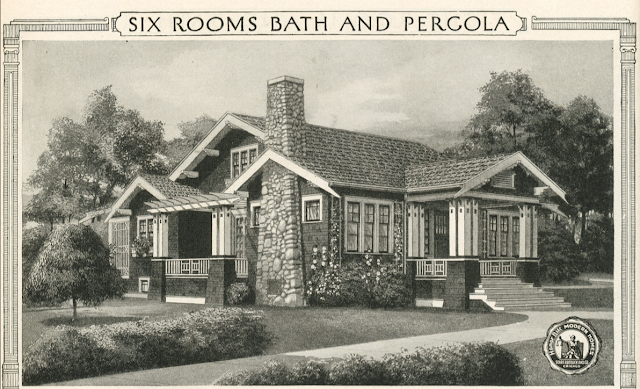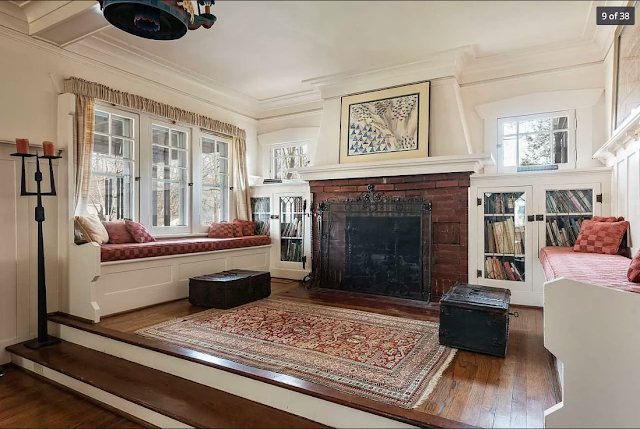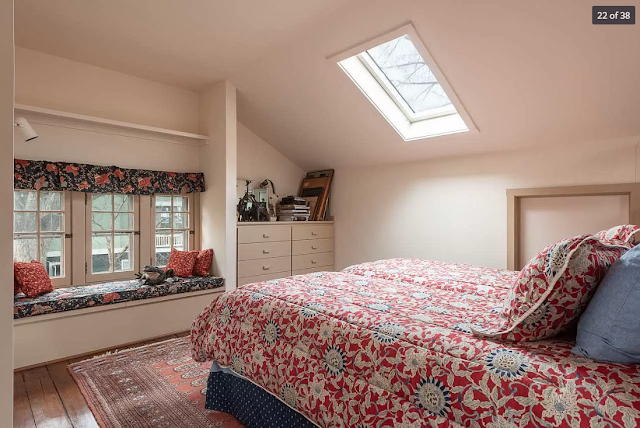 |
| Sears House Model No. 108, as it appeared in the 1912 Sears Modern Homes catalog. |
Happy New Year! It's 2020, and we're excited to continue our searching for Sears Modern Homes, many of which were built during that exciting decade that began 100 years ago, the 1920s. However, today's blog post takes us back to the very early years of the Sears Modern Homes program, to take a look at a short-lived model whose run spanned 1908-1913... and then it disappeared, to have its model number unceremoniously re-assigned to a different house. I'm talking about the rare model No. 108, that you see above.
Up until a week ago, we had only one No. 108 on our National Database of Sears Houses In The U.S.. It was a testimonial house that had been mentioned by a real estate developer in Norwich, Connecticut. He wrote in to tell of the four Sears houses that he had built in town, and one of those was the No. 108. We didn't know exactly what year he sent in that letter, but, once we had seen that No. 108 in Norwich, CT, we knew that he had to have built those houses pretty close to 1908, because the design of the No. 108 that he built, was changed by the 1912 catalog. The very first offering of this model was in 1908, and it looked like this:
 |
26 Kinney Avenue, Norwich, Connecticut •
Sears No. 108, first version, as shown in a 1910 Sears general merchandise catalog, in an ad for Seroco paint.
This home is presented in this interesting blog post about the houses from the W.W. Beckwith testimonial. |
See that corner bumpout? It's kind of awkward, I have to say, but it helps us date the house... and, from the inside, it does add a nice bit of space to that parlor, and looks fine. Here's what I'm referring to:
 |
| See those areas that I boxed in? That's the corner bump-out. |
A bit of research in a historic newspaper database, netted me some really helpful information that now allows us to date the building of the testimonial No. 108 in Norwich, most likely to 1910. Though this house from Beckwith's testimonial letter, was built on Kinney Avenue, the other three of those four houses that Beckwith wrote in about, were found on Thames Street, the street on which Beckwith lived, according to the address given on his letter to Sears. Here's a mention, in a May 1910 newspaper, of W.W. Beckwith involved in a sale of properties on Thames Terrace (a street near Thames Street) and Kinney Avenue:
 |
| Norwich Bulletin, May 27, 1910 Page 11 |
We see mention of Beckwith's building endeavors on those two streets two days before that, on May 25, 1910:
 |
| Norwich Bulletin, Norwich, Connecticut, May 25, 1910, page 5 |
According to the 1910 Norwich City Directory, Austin Perkins lived at 130 West Thames Street, so I imagine that one of the Beckwith Sears houses -- found at 124, 136, and 140, on West Thames -- is the house being referred to here.
 |
| Norwich City Directory, 1910 |
The 1913-Era Sears No. 108
So, as I mentioned, that was the only No. 108 that we had on our national database. That is... until the owner of a Liberty, Indiana house, asked about her house, in a small Sears Kit Houses group that some of us are in, on FaceBook. She had always been told that their house was a Sears house, but had never been able to find what model it was. Well... no wonder. The early No. 108 was, for some reason, left out of the best reference resource out there for the history of Sears Houses, which also includes catalog images of (almost) all of the Sears models:
Houses By Mail. It was just before Christmas, and everyone was busy, and no one really answered Amanda's question about her house. A couple of days after Christmas, I checked back in... and had a thought... I decided to check the re-print 1913 catalog (Amanda had said that her house was built in 1913, but build date information is often incorrect in town resources), to look for that house.... that No. 10-something... I had looked around for it before... and I thought it had these lines. And... yup! That's the one! The 108! So, I messaged Amanda...

And, she said...
I realized, then, that we had no other No. 108 models of this version, on our national database, so I was really pleased to be able to add Amanda's house to our list. As we exchanged some more information outside of the group, I learned that not only was Amanda's house a No. 108, but that there was another No. 108 in Liberty, Indiana, as well! Two brothers had built the houses, in two different areas of the small town of Liberty, and, so, that meant that I would be adding not one, but two more model No. 108s to our list. Woo hoo!
Let's take a look at both of these houses, which are both light grey, just like the one in Norwich is... although... you'll notice that these two houses have a flat front. That awkward corner bump-out was removed from the Sears design, beginning, probably, in 1912 (I've not seen a 1911 catalog, but I assume that, since the color ad for Seroco paints, in the 1910 general Sears catalog, shows the earlier design, that the design had not yet been changed in 1910):
 |
| Here is the new, and last, version of the No. 108, in the 1912 catalog. |
Amanda's house sits on farmland, on the outskirts of Liberty. Amanda knew the last name of the two brothers who had built the twin Sears houses--Huntington--and a little research on Ancestry.com, led me to learn that the brothers' first names were Harry, and Howard. Harry is the brother who built Amanda's house, and he would have been 30 that year, while Howard would have been 29 if he built his house that same year. It is likely that the build date of 1913 is correct, since that is the last year that this model was offered in the Sears Modern Homes catalogs (beginning in 1916, the number 108 was assigned to the model we know as the
Saratoga, which, before 1916, had been the No. 146 -- you can read about that model in
this blog post of mine ).
Here is Harry's No. 108, Amanda's home:
 |
| Harry and Mima Huntington's Sears No. 108, built in 1913. They lived here with their young son, Maurice, until Harry's death in 1918. I believe that Mima eventually moved away from this house, re-marrying in 1925, to Charles Chowning. They divorced in the early 1940s, according to information on the Find-A-Grave website. Interestingly, when Mima passed away in 1956, she was buried in the Harry Huntington family plot, and her name was placed on the tombstone with his. |
 |
| There is the side bumpout for the dining room... and the clean-cut front corner, where the corner bump-out was omitted from the design. |
 |
| What a welcoming front porch! |
 |
| Google Streetview's images are not as nice and clear as Amanda's, but they do show us how well the house follows the design of the No. 108, with the obvious addition added on to the back. |
 |
| We can see that the house had an extension put on the back, but the rest of the lines follow just as they should, for the No. 108. |
 |
| I didn't realize the significance of this, until I read more about Mima's life after Harry's 1918 death. Despite her marriage to Charles Chowning, in 1925, which ended in divorce, she was laid to rest with her first husband. I imagine that their son, Maurice, had a hand in that. |
Amanda very kindly shared photos of brother Howard's house, which is on a street in town in Liberty. Howard lived here with his wife, Stella, and their sons, Marion and Lawrence:
 |
| There is a small extension on the back of Howard & Stella's house, too... there should be a back porch there, but it has probably been enclosed, and maybe extended across the back of the house. |
 |
| Again, you can see a slight extension to the back of the house, behind the short double windows of the kitchen. The house should normally stop right behind those kitchen windows. |
 |
| Both Huntington brothers opted to make that upper front window into a single, instead of the double that is shown in the catalog image. By the way, these houses would have been built before the pre-cut era (which began in 1916), so the lumber would have been supplied in standard lengths. In homes before the pre-cut era, we see a little more leeway in construction, and it's more likely to find houses that differ a bit from the catalog, in this era, when builders could have made changes at the build site. Sears may have been more willing to offer small changes in design at this time, too, since it didn't mean much difference in what they supplied to the homeowner. |
But, wait... there's more!
I have to thank Amanda for sharing her photos with me, and allowing me to blog about her home, and its twin, in town. The image that I showed her, at first, in fact, was from the 1913 catalog. And... on that catalog page, there was a little box that we call the "built-at box"... it's where Sears mentioned the locations where other homes of that model had been built...at:
 |
| The No. 108 in its last appearance in the Sears Modern Homes catalogs... the 1913 edition. That catalog is available as a re-print, published by Dover books, and is available on Amazon, here. |
So, for a lark, I thought I'd pick one of the towns mentioned, and look around a bit. This isn't my favorite method of researching... I get irritated when Google streetview goes slowly, and I get frustrated when I don't find the house I'm looking for. So, I didn't think I'd be long for this search. But... when I looked at the outline of West Haverstraw, New York, on Google maps, I looked a bit at the street names, and randomly picked one to plop down on. I chose Center Avenue, and plopped down right where the green arrow is.

Then... looking down the street that intersected it -- Demarest Avenue -- I found Sears No. 108 number three! There, sitting at #12, Demarest Avenue, is a house that looks to fit the bill very nicely. Sure, it has a bay window added in front, but, otherwise, it's a great match for the No. 108, 1913 version. And, since that town was mentioned in the 1913 catalog, and the house is of the second style of this model, without the side bump-out, the house on Demarest must must have been built around 1911 or 1912. Here it is!:
 |
| 12 Demarest Avenue, West Haverstraw, New York • Sears No. 108 • Built in 1911 |
 |
| You can see that the house ends just behind the kitchen window, whereas the Liberty, Indiana examples, were extended. |
 |
| There are the expected two upper front windows. They are shorter than full size, and my guess is that this helps us to know that they were replaced whenever that front bay window was added. I'll bet that, during that construction project, they needed to cut into the space down to which the upper windows would normally extend. |
The real estate listing for this house (which has had the same owners since 1979), says that it was built in 1911. In this instance, I'd say that is most likely correct, or very closely. It wouldn't have been this design, if it had been before that, and it wouldn't have made it into the mention in the 1913 catalog, if it had been much later.
But... What About The Inside?
That is always my first thought... what does this house look like inside!?? So, I always search the real estate listings for a possible recent listing, with good photos. Well, we are in luck! The early No. 108, the one in Norwich, Connecticut, the one with the funky front corner bump-out, was for sale in 2018. And, there are
great photos with the listing! Without further ado, let's take a look at what the interior of an early Sears No. 108 looks like:
 |
| 26 Kinney Avenue, Norwich, Connecticut • Sears No. 108 |
 |
| The listing provided a nice little copy of the Sears catalog's floorplan image. |
 |
| Here's the staircase newel, in the 1912 Sears Building Supplies catalog. |
 |
| Display rail for china, Craftsman trim around the windows and doors, and faux beams on the ceiling of the dining room! |
 |
| Here we see the side bay window of the dining room... and, off in the distance, the not-quite-as-awkward-as-outside corner bump-out of the front parlor. |
 |
| See that stained-glass window? I believe that's original to the house. Interesting pattern to the layout of the hardwood floor. |
 |
| Here's a very close match to the stained glass in the window on our Norwich No. 108. This is from the 1912 building materials catalog. You would expect it to look exactly like the image in the catalog, but we often see stained glass in our Sears houses, that either doesn't match anything in the catalog, or is slightly different. |
 |
| There's that little reading nook! That corner bump-out looks kind of nice inside the house. |
 |
| "Reception Hall", as it is called in the original Sears plans. Now, it's called the living room, and the front parlor is called the family room. |
Here's the upstairs plan, and one of the upstairs bedrooms:
 |
| I chose this one to grabe a photo of, because I wanted to check out that door handle hardware. |
 |
| Unfortunately, I don't see a match for this door handle hardware, in the catalogs. |
Here's a funny thing: The real estate listing gives build year for this house as 1929. This information would surely have come from the town's assessor records. Well... nope! We know for certain that this house was built almost two decades before that. This is why we definitely don't automatically trust town assessor records.
 |
| Nope! Not 1929. More likely, 1910. |
Since we so rarely get to see the rear of our Sears houses, let's grab that last photo, so you can see what the back porch normally looks like on this model:
 |
| Sears No. 108, 1912-1913 version, rear. |
And, with that, I'll wrap it up! I'm pretty pleased to have been able to add three more of this model, to our national database, and loved getting to see the inside views of this cool model. I hope the new owners are enjoying it!





























































